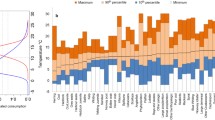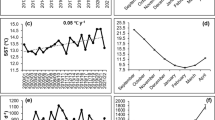Abstract
The Barents Sea area is characterised by a highly fluctuating physical environment causing substantial variations in the ecosystems and fisheries depending upon this. Simulations assuming different management regimes have been carried out to study how physical and biological effects of global warming influence the Barents Sea cod fisheries. A regional, high-resolution representation of the B2 world region (OECD90) scenario from the Intergovernmental Panel on Climate Change was used to calculate water temperatures and plankton biomasses by hydrodynamic modelling. These results were included in simulations performed by a multi-fleet, multi-species model, by which a fully integrated model linking to the global circulation model to the Barents Sea fisheries through a regional downscaling to the Barents Sea area is constructed. One factor of particular importance for the natural annual biological variations is the occasional inflow of young herring into the Barents Sea area. The herring inflow is difficult to predict and links to dynamical systems outside the Barents Sea area, complex recruitment mechanisms and oceanographic conditions. These processes are in the study represented by a stochastic representation of herring inflow based on historical observations. According to the performed simulations the biomass fluctuations may slightly increase over the next 25 years, possibly caused by changes in temperature patterns. Six different management regimes have been included in the study and the results support earlier studies claiming that the choice of management regime potentially has a greater importance for biological and economic performance in the Barents Sea fisheries than impacts which derive from global warming over the next 25 years. A basic assumption for this conclusion is however that the Barents Sea ecosystem essentially preserves its structure and composition of today. Possible, unpredictable significant shifts in the ecosystem structure are not considered.
Similar content being viewed by others
References
Anon (2000) Lønnsomhetsundersøkelser for helårsdrevne fiskefartøy 8 meter største lengde og over. (In Norwegian). The Norwegian Fisheries Directorate. Bergen, Norway
Åsnes M (2005) Prost users guide, internal note, Norwegian Institute of Marine Research (IMR). Bergen, Norway
Eide A (2007) Economic impacts of global warming – the case of the Barents Sea fisheries. Natural Resource Modeling 20(2):199–221
Eide A, Flaaten O (1998) Bioeconomic multispecies models of the Barents Sea fisheries. In: Rødseth T (ed.) models for multispecies management. Physica-Verlag, Heidelberg, New York, pp 141–17, ISBN 3-7908-1001-0
Eide A, Heen K (2002) Economic impacts of global warming. A study of the fishing industry in North Norway. Fish Res 56:261–274
Huse G, Railsback S, Fernø A (2002) Modelling changes in migration pattern of herring: collective behaviour and numerical domination. J Fish Biol 60:571
Jacob D, Andrae U, Elgered G, Fortelius C, Graham LP, Jackson SD, Karstens U, Koepken C, Lindau R, Podzun R, Rockel B, Rubel F, Sass HB, Smith RND, van den Hurk BJJM, Yang X (2001) A comprehensive model intercomparison study investigating the water budget during the BALTEX-PIDCAP Period. Meteorol Atmos Phys 77:19–43
Nakícenovíc N, Alcamo J, Davis G, de Vries B, Fenhann J, Gaffin S, Gregory K, Grübler A, Jung TY, Kram T, Emilio la Rovere E, Michaelis L, Mori S, Morita T, Pepper W, Pitcher H, Price L, Riahi K, Roehrl A, Rogner H-H, Sankovski A, Schlesinger ME, Shukla PR, Smith S, Swart RJ, van Rooyen S, Victor N, Dadi Z (2000) Special report on emissions scenarios. Cambridge University Press, Cambridge, pp 599
Parry MP, Canziani OF, Palutikof J (eds) (2007) Climate Change 2007. Impacts, adaptation and vulnerability. Cambridge University Press, Cambridge, (in press).
Pedersen OP, Slagstad D, Tande K (2003) Hydrodynamic model forecasts as a guide for process studies on plankton and larval fish. Fish Oceanogr 12(4/5):369–380
Roeckner E, Arpe K, Bengtsson L, Christoph M, Claussen M, Dümenil L, Esch M, Giorgetta M, Schlese U, Schulzweida U (1996) The atmospheric general circulation model ECHAM4: Model description and simulation of present-day climate. Max-Planck-Institut für Meteorologie, Hamburg, Report No. 218.
Slagstad D, McClimans TA (2005) Modeling the ecosystem dynamics of the Barents Sea including the marginal ice zone: I. Physical and chemical oceanography. J Mar Syst 58(25):1–18
Thompson G (1999) Optimizing harvest control rules. In: presence of natural variability and parameter uncertainty. Proceedings, 5th NMFS NSAW. NOAA Tech. Memo. NMFSF/SPO-40.
Tjelmeland S, Bogstad B (1998) Biological modelling. In: Models for multispecies management. Physica-Verlag, Heidelberg, New York, pp 69–92 ISBN 3-7908-1001-0
Ursin E (1967) A mathematical model of some aspects of fish growth, respiration, and mortality. J Fish Res Board Can 24(11):2355–2453
Wikan A, Eide A (2004) An analysis of a nonlinear stage-structured cannibalism model with application on the Northeast Arctic cod stock. Bull Math Biol 66:1685–1704
Author information
Authors and Affiliations
Corresponding author
Rights and permissions
About this article
Cite this article
Eide, A. An integrated study of economic effects of and vulnerabilities to global warming on the Barents Sea cod fisheries. Climatic Change 87, 251–262 (2008). https://doi.org/10.1007/s10584-007-9338-0
Received:
Accepted:
Published:
Issue Date:
DOI: https://doi.org/10.1007/s10584-007-9338-0




